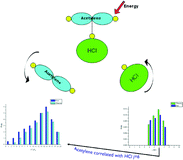The mechanism of H-bond rupture: the vibrational pre-dissociation of C2H2–HCl and C2H2–DCl
Abstract
Pair correlated fragment rovibrational distributions are presented following vibrational predissociation of the C2H2–DCl van der Waals dimer initiated by excitation of the asymmetric (asym) C–H stretch. The only observed fragmentation pathways are DCl (v = 0; j = 6–9) + C2H2 (ν2 = 1; j = 1–5). These and previously reported data on the related C2H2–HCl species are analysed using the angular momentum (AM) method. Calculations accurately reproduce fragment rovibrational distributions following dissociation of the C2H2–HCl dimer initiated either by excitation of the asym C–H stretch or via the HCl stretch, and those from C2H2–DCl initiated via asym C–H stretch excitation. The calculations demonstrate that the dimer is bent at the moment of dissociation. Several geometries are found that lead to H-bond breakage via a clearly identified set of fragment quantum states. The results suggest a hierarchy in the disposal of excess energy and angular momentum between fragment vibration, rotation and recoil. Deposition of the largest portion of energy into a C2H2 vibrational state sets an upper limit on HCl rotation, which then determines the energy and AM remaining for C2H2 rotation and fragment recoil. Acceptor C2H2 vibrational modes follow a previously noted propensity, implying that the dissociating impulse must be able to induce appropriate nuclear motions both in the acceptor vibration and in rotation of the C2H2 fragment.


 Please wait while we load your content...
Please wait while we load your content...